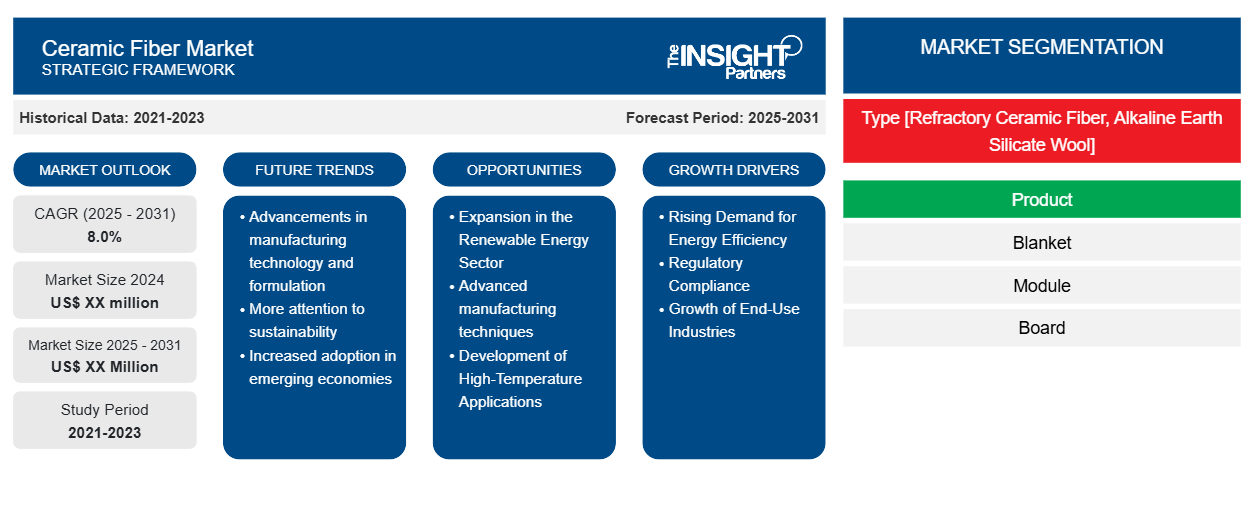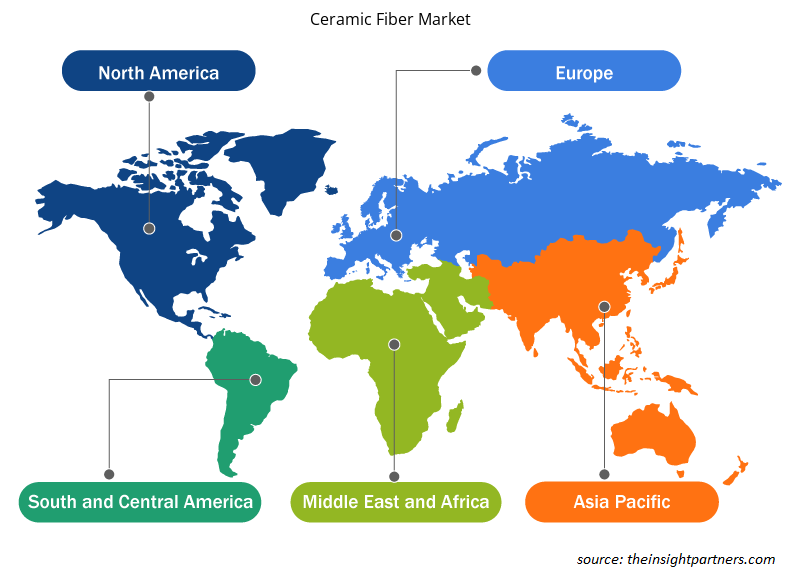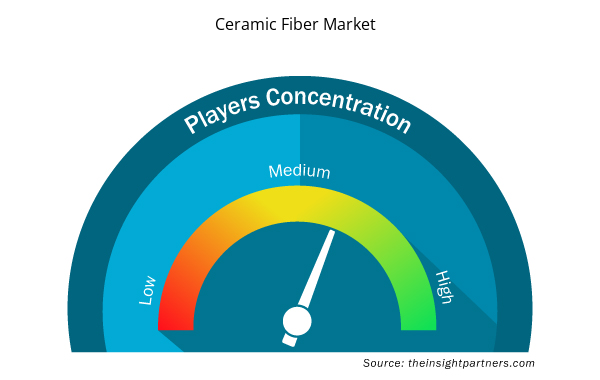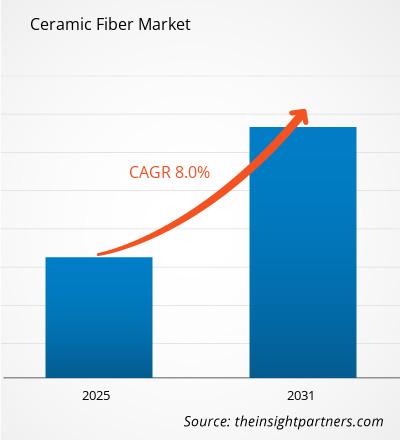The Ceramic Fiber Market is expected to register a CAGR of 8.0% from 2025 to 2031, with a market size expanding from US$ XX million in 2024 to US$ XX Million by 2031.
The ceramic fiber market is segmented into type, product, and end use. Based on type, the market is segmented into refractory ceramic fiber, alkaline earth silicate wool, and others. Based on product, the ceramic fiber market is segmented into blanket, module, board, paper, and others. Based on end use, the market is segmented into iron and steel, refining and petrochemicals, power generation, aluminum, and others. The report scope covers five regions: North America, Europe, Asia Pacific, Middle East and Africa, and South and Central America and key countries under each region. The global analysis is further broken down at the regional level and major countries. The Report Offers the Value in USD for the above analysis and segments.
Purpose of the Report
The report Ceramic Fiber Market by The Insight Partners aims to describe the present landscape and future growth, top driving factors, challenges, and opportunities. This will provide insights to various business stakeholders, such as:
- Technology Providers/Manufacturers: To understand the evolving market dynamics and know the potential growth opportunities, enabling them to make informed strategic decisions.
- Investors: To conduct a comprehensive trend analysis regarding the market growth rate, market financial projections, and opportunities that exist across the value chain.
- Regulatory bodies: To regulate policies and police activities in the market with the aim of minimizing abuse, preserving investor trust and confidence, and upholding the integrity and stability of the market.
Ceramic Fiber Market Segmentation
Type [Refractory Ceramic Fiber, Alkaline Earth Silicate Wool]
Product
- Blanket
- Module
- Board
- Paper]
End Use
- Iron and Steel
- Refining and Petrochemical
- Power Generation
- Aluminum]
Geography
- North America
- Europe
- Asia-Pacific
- South and Central America
- Middle East and Africa
You will get customization on any report - free of charge - including parts of this report, or country-level analysis, Excel Data pack, as well as avail great offers and discounts for start-ups & universities
Ceramic Fiber Market: Strategic Insights

- Get Top Key Market Trends of this report.This FREE sample will include data analysis, ranging from market trends to estimates and forecasts.
Ceramic Fiber Market Growth Drivers
- Rising Demand for Energy Efficiency: The rising demand for energy efficiency is significantly boosting the role of ceramic fibers, especially in industries where thermal insulation is critical. Given the increasing concern over energy costs in power generation, manufacturing, and other industrial sectors, ceramic fibers are increasingly recognized as agents to minimize heat loss, reduce energy consumption, and improve system performance. These fibers provide great thermal insulation properties, and with their use, industries are able to reduce their energy costs and carbon footprint. With the increase in sustainability targets and the quest for improvement in energy efficiency, companies are turning towards ceramic fibers as an ideal solution to achieve long-term cost savings and environmental benefits.
- Regulatory Compliance: Newly stringent emission and environmental regulations force industries to use advanced materials such as ceramic fibers. Not only are they environment-friendly, but they also satisfy the requirements of increased insulation with proper management of heat for regulatory compliance.
- Growth of End-Use Industries: Improvements in the aerospace, automotive, and petrochemical industries are one of the significant growth drivers for the ceramic fiber market. The increased momentum of these industries has upped the demand for high-temperature-resistant material used in insulation.
Ceramic Fiber Market Future Trends
- Advancements in manufacturing technology and formulation: Advanced ceramic fibers are developed as a result of the advancement in manufacturing techniques and formulations. Such advancements would have better withstood rigorous high temperature environments as well as elongated the life cycle of the material.
- More attention to sustainability: Manufacturing processes and materials are more sustainable nowadays. Firms now focus more on recyclable as well as environmentally friendly materials, which align with the properties of ceramic fibers.
- Increased adoption in emerging economies: The adoption of ceramic fiber is rapidly increasing in emerging economies due to industrial growth, infrastructure development, and growing interest in energy efficiency. As these economies expand their manufacturing capabilities, particularly in sectors like steel, cement, automotive, and energy, the demand for high-performance insulation materials like ceramic fiber is surging. Ceramic fiber has excellent heat resistance, is lightweight, and saves energy, which makes it suitable for use in high-temperature industrial processes, thereby helping companies save energy and improve efficiency.
Ceramic Fiber Market Opportunities
- Expansion in the Renewable Energy Sector: he growth in the renewable energy sector has substantially increased demand for ceramic fiber, one of the major materials which is known for its good thermal resistance and insulation properties. As the technologies associated with renewable energy sources grow, such as wind, solar, and geothermal power, so too does the application of ceramic fiber in energy-efficient applications in the insulation of equipment, such as turbine blades, solar panels, and geothermal power plants. Its ability to maintain energy efficiency even at high temperatures is vital for the improvement of renewable energy systems in terms of performance and lifespan.
- Advanced manufacturing techniques: Advanced manufacturing techniques such as additive manufacturing have become an emerging avenue for ceramic fibers because they allow incorporation into truly innovative designs with performance maximization and waste minimization in mind.
- Development of High-Temperature Applications: These industries are increasingly interested in increasing operating temperatures and, consequently, the growing demand for custom ceramic fibers with higher operating temperatures. Manufacturer is an opportunity to produce specialized solutions tailored to their critical requirements.
Ceramic Fiber Market Regional Insights
The regional trends and factors influencing the Ceramic Fiber Market throughout the forecast period have been thoroughly explained by the analysts at Insight Partners. This section also discusses Ceramic Fiber Market segments and geography across North America, Europe, Asia Pacific, Middle East and Africa, and South and Central America.

- Get the Regional Specific Data for Ceramic Fiber Market
Ceramic Fiber Market Report Scope
| Report Attribute | Details |
|---|---|
| Market size in 2024 | US$ XX million |
| Market Size by 2031 | US$ XX Million |
| Global CAGR (2025 - 2031) | 8.0% |
| Historical Data | 2021-2023 |
| Forecast period | 2025-2031 |
| Segments Covered |
By Type [Refractory Ceramic Fiber, Alkaline Earth Silicate Wool]
|
| Regions and Countries Covered | North America
|
| Market leaders and key company profiles |
Ceramic Fiber Market Players Density: Understanding Its Impact on Business Dynamics
The Ceramic Fiber Market is growing rapidly, driven by increasing end-user demand due to factors such as evolving consumer preferences, technological advancements, and greater awareness of the product's benefits. As demand rises, businesses are expanding their offerings, innovating to meet consumer needs, and capitalizing on emerging trends, which further fuels market growth.
Market players density refers to the distribution of firms or companies operating within a particular market or industry. It indicates how many competitors (market players) are present in a given market space relative to its size or total market value.
Major Companies operating in the Ceramic Fiber Market are:
- Great Lakes Textiles
- HarbisonWalker International
- Isolite Insulating Products Co., Ltd.
- Lewco Specialty Products, Inc.
- Luyang Energy-saving Materials Co.,Ltd
Disclaimer: The companies listed above are not ranked in any particular order.

- Get the Ceramic Fiber Market top key players overview
Key Selling Points
- Comprehensive Coverage: The report comprehensively covers the analysis of products, services, types, and end users of the Ceramic Fiber Market, providing a holistic landscape.
- Expert Analysis: The report is compiled based on the in-depth understanding of industry experts and analysts.
- Up-to-date Information: The report assures business relevance due to its coverage of recent information and data trends.
- Customization Options: This report can be customized to cater to specific client requirements and suit the business strategies aptly.
The research report on the Ceramic Fiber Market can, therefore, help spearhead the trail of decoding and understanding the industry scenario and growth prospects. Although there can be a few valid concerns, the overall benefits of this report tend to outweigh the disadvantages.
- Historical Analysis (2 Years), Base Year, Forecast (7 Years) with CAGR
- PEST and SWOT Analysis
- Market Size Value / Volume - Global, Regional, Country
- Industry and Competitive Landscape
- Excel Dataset



Report Coverage
Revenue forecast, Company Analysis, Industry landscape, Growth factors, and Trends

Segment Covered
Type, Product, and End Use

Regional Scope
North America, Europe, Asia Pacific, Middle East & Africa, South & Central America

Country Scope
This text is related
to country scope.
Frequently Asked Questions
What is the furture trend for ceramic fiber market?
Growth in technological advancement is expected to be the key market trend.
What are the deliverable formats of the ceramic fiber market?
The report can be delivered in PDF/Word format, we can also share excel data sheet based on request.
Which regions are covered in the report?
On the basis of geography, the ceramic fiber market is classified into North America, Europe, Asia Pacific, Middle East and Africa, and South and Central America
What are the key players operating in the ceramic fiber market?
Great Lakes Textiles, HarbisonWalker International, Isolite Insulating Products Co., Ltd., Lewco Specialty Products, Inc., Luyang Energy-saving Materials Co.,Ltd, Morgan Advanced Materials, Nutec Group, Pyrotek Inc., Rath-Group, and Unifrax LLC are some of the players operating in the market.
What are the driving factors impacting the ceramic fiber market?
The major factors driving the ceramic fiber market are:
1. Rising Demand for Energy Efficiency
2. Growth in End-Use Industries
What is the expected CAGR of the Ceramic Fiber Market?
The Ceramic Fiber Market is estimated to witness a CAGR of 8.0% from 2023 to 2031
Trends and growth analysis reports related to Chemicals and Materials : READ MORE..
The List of Companies
- Great Lakes Textiles
- HarbisonWalker International
- Isolite Insulating Products Co., Ltd.
- Lewco Specialty Products, Inc.
- Luyang Energy-saving Materials Co.,Ltd
- Morgan Advanced Materials
- Nutec Group
- Pyrotek Inc.
- Rath-Group
- Unifrax LLC

 Get Free Sample For
Get Free Sample For